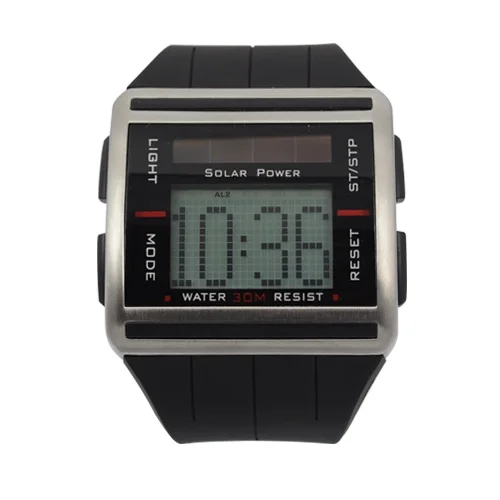Solar-powered watch
Most wrist watches are powered by either a built-in replaceable battery or by a winding mechanism. A solar watch, however, is powered by a series of built-in solar cells, usually located above the watch’s face. The watch is still powered by electricity, however; the solar cells simply convert the solar energy into electricity. Excess electricity is stored in a battery. This way, the watch can keep ticking day-round, regardless of whether its owner is outside or not.
A solar-powered watch is a watch that is powered entirely or partly by a solar panel.
Typically, sunlight and artificial light are absorbed by a solar panel behind the crystal. The dial is either on a layer above or actually on the solar panel. This solar panel converts the light into electrical energy to power the watch. The watch will usually store energy in a rechargeable cell to power itself during the night or when covered such as by a person’s sleeve. Citizen’s watches use lithium-ion batteries to store sufficient energy to power the watch for several months/years of darkness. However, this (years) figure assumes that the watch enters a power-saving mode during which the seconds hand stops until the watch is re-exposed to light. Not all have a power-save mode, yet will still hold a charge for typically six months, such as fairly uncomplicated (date only) analog versions made by Citizen.
How Do They Work?
When light particles, or photons, bombard the layer with missing electrons, electrons are knocked into the opposite layer. In this way, that layer always has fewer electrons, which attracts new photons to it. The process is never reversed; an electric one-way system is set up so that electrons can only flow from the deficit layer to the surplus layer, and not the other way around. When either the sun’s photons or the other layer’s electrons strike the layer with more electrons than it needs, something different happens. Instead of being knocked over to the other layer, a wire is attached to the surplus layer, absorbing electrons—electricity—and using them to power the watch’s battery. After passing through the battery, “used” electrons follow along a different wire and are deposited back in the deficit layer of silicon, readying them for use again. As long as the sun is hitting the watch’s solar cells, the electrons will keep cycling through, adding power to the watch’s battery.
There are other components in the watch’s solar cells that make it function more efficiently. The silicon layers have to absorb the light to make use of it, but silicon is naturally a very shiny material. If left untreated, the majority of the sunlight would bounce off its surface, making the PV cell useless. To counter this, the solar cells are covered in a layer of anti-reflective material, and a clear material such as glass or plastic is placed over the cell to protect it from damage.




